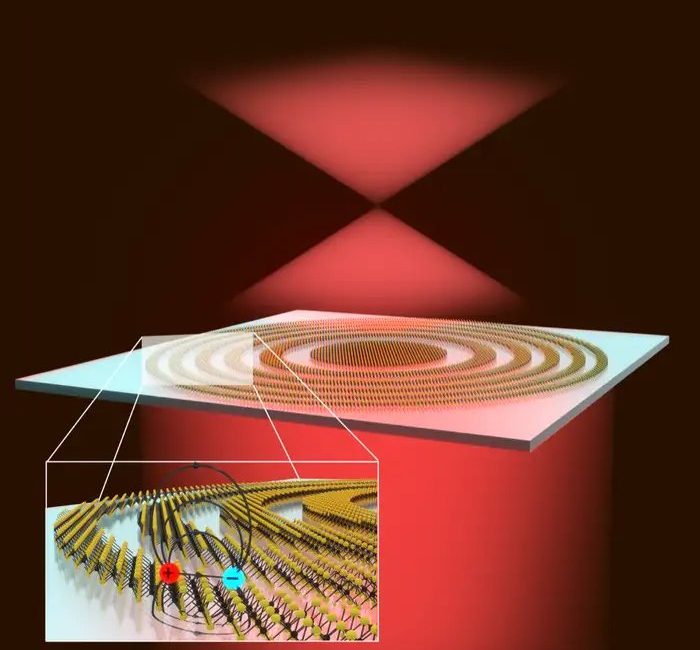(Nanowerk News) Lenses are used to bend and focus light. Normal lenses rely on their curved shape to achieve this effect, but physicists from the University of Amsterdam and Stanford University have made a flat lens of only three atoms thick which relies on quantum effects. This type of lens could be used in future augmented reality glasses.
The findings have been published in Nano Letters (“Temperature-Dependent Excitonic Light Manipulation with Atomically Thin Optical Elements”).
 The thinnest lens on Earth, made of concentric rings of tungsten disulphide (WS2), uses excitons to efficiently focus light. The lens is as thick as a single layer of WS2, just three atoms thick. The bottom left shows an exciton: an excited electron bound to the positively charged ‘hole’ in the atomic lattice. (Image: Ludovica Guarneri and Thomas Bauer)
When you imagine a lens, you probably picture a piece of curved glass. This type of lens works because light is refracted (bent) when it enters the glass, and again when it exits, allowing us to make things appear larger or closer than they actually are. We have used curved lenses for more than two millennia, allowing us to study the movements of distant planets and stars, to reveal tiny microorganisms, and to improve our vision.
Ludovico Guarneri, Thomas Bauer, and Jorik van de Groep of the University of Amsterdam, together with colleagues from Stanford University in California, took a different approach. Using a single layer of a unique material called tungsten disulphide (WS2 for short), they constructed a flat lens that is half a millimetre wide, but just 0.0000006 millimeters, or 0.6 nanometers, thick. This makes it the thinnest lens on Earth!
Rather than relying on a curved shape, the lens is made of concentric rings of WS2 with gaps in between. This is called a ‘Fresnel lens’ or ‘zone plate lens’, and it focuses light using diffraction rather than refraction. The size of, and distance between the rings (compared to the wavelength of the light hitting it) determines the lens’s focal length. The design used here focuses red light 1 mm from the lens.
The thinnest lens on Earth, made of concentric rings of tungsten disulphide (WS2), uses excitons to efficiently focus light. The lens is as thick as a single layer of WS2, just three atoms thick. The bottom left shows an exciton: an excited electron bound to the positively charged ‘hole’ in the atomic lattice. (Image: Ludovica Guarneri and Thomas Bauer)
When you imagine a lens, you probably picture a piece of curved glass. This type of lens works because light is refracted (bent) when it enters the glass, and again when it exits, allowing us to make things appear larger or closer than they actually are. We have used curved lenses for more than two millennia, allowing us to study the movements of distant planets and stars, to reveal tiny microorganisms, and to improve our vision.
Ludovico Guarneri, Thomas Bauer, and Jorik van de Groep of the University of Amsterdam, together with colleagues from Stanford University in California, took a different approach. Using a single layer of a unique material called tungsten disulphide (WS2 for short), they constructed a flat lens that is half a millimetre wide, but just 0.0000006 millimeters, or 0.6 nanometers, thick. This makes it the thinnest lens on Earth!
Rather than relying on a curved shape, the lens is made of concentric rings of WS2 with gaps in between. This is called a ‘Fresnel lens’ or ‘zone plate lens’, and it focuses light using diffraction rather than refraction. The size of, and distance between the rings (compared to the wavelength of the light hitting it) determines the lens’s focal length. The design used here focuses red light 1 mm from the lens.

